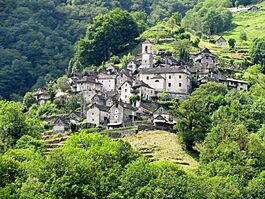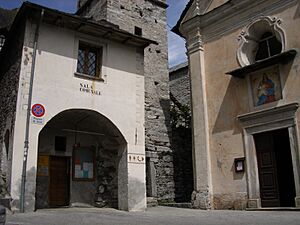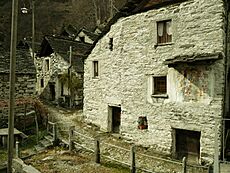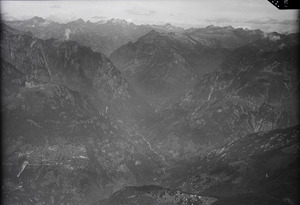Corippo facts for kids
Quick facts for kids
Corippo
|
||
|---|---|---|
 |
||
|
||
| Country | Switzerland | |
| Canton | Ticino | |
| District | Locarno | |
| Area | ||
| • Total | 7.73 km2 (2.98 sq mi) | |
| Elevation | 558 m (1,831 ft) | |
| Population
(2019)
|
||
| • Total | 9 | |
| • Density | 1.16/km2 (3.02/sq mi) | |
| Postal code |
6631
|
|
| Surrounded by | Gordevio, Lavertezzo, Mergoscia, Vogorno | |
Corippo was a small village and former town (called a municipality) in the Locarno area of Ticino in Switzerland.
In July 2018, Corippo had only 12 people living there. By December 2019, this number dropped to just 9. This made it the smallest municipality in all of Switzerland! Even though it was tiny, Corippo had many things bigger towns have. It had its own website (www.corippo.ch), a special coat of arms, a village church, a restaurant, and even a mayor who worked with a small town council. Corippo was an independent town since 1822. However, on October 17, 2020, Corippo joined with other nearby towns like Vogorno, Sonogno, Brione (Verzasca), and Frasco. They all became part of a new, bigger town called Verzasca. Together, they had about 640 people.
Contents
About Corippo Village
Corippo is a mountain village located in the Verzasca valley. It is about 12 kilometers (7.5 mi) from Locarno. It sits near the northern end of a man-made lake called Lake Vogorno. The village is also about 20 km (12 mi) from the border with Italy.
The houses in Corippo are built from a local stone called Ticino granite. Their roofs are made of slate. These buildings have looked almost the same for hundreds of years. An Italian writer named Piero Bianconi once called Corippo "Verzasca's gentlest village."
The village has a church built in the early 1600s. It was first called the Church of the Blessed Virgin Annunciata. Later, it was renamed the Blessed Virgin Carmine. The church was made bigger in the late 1700s. Corippo is so special that its entire village center is protected. In 1975, a group called the European Architectural Heritage Congress said Corippo was a great example of how to save historical places.
Corippo was once part of a larger area called Vogorno. It had some freedom but became a fully independent town in 1822. In 1883, a road was built. This road connected Corippo to the main Verzasca valley road, linking it to the outside world.
Over time, many people left Corippo. This happened because there wasn't enough farmland or jobs. People, who used to be farmers and herdsmen, moved to bigger towns. In the last 150 years, the village's population has dropped by more than 94%.
Village History
Corippo was first mentioned in old writings in 1224. Back then, it was called Culipo. Later, in 1374, it was known as Quorippo.
Where is Corippo?
In 1997, Corippo covered an area of about 7.73 square kilometers (2.98 sq mi). A small part of this land (0.9%) was used for farming. A large part (64.0%) was covered in forests. A tiny bit (0.3%) had buildings or roads. About 4.3% was rivers or lakes. The rest (23.4%) was land that couldn't be used for farming or building.
The village is in the Locarno district. It sits on the western side of the Verzasca valley, above a lake. Corippo is a haufendorf village. This means it's an unplanned village with houses built close together around a central area.
Corippo's Coat of Arms
The blazon of Corippo's coat of arms shows a black mountain goat standing on green hills. This design is on a silver background.
People of Corippo
In December 2019, Corippo had 9 people living there. In 2008, about 5.6% of the people were foreign nationals. Most people (86.4% in 2000) spoke Italian. The rest spoke German.
In 2008, there were 7 Swiss men and 1 non-Swiss man. There were 7 Swiss women and no non-Swiss women. In 2008, one Swiss person passed away. This meant the Swiss population in Corippo went down by 1 person that year.
In 2009, there were no children or teenagers (ages 0-19) living in Corippo. There were also no young adults (ages 20-29). One person was between 30 and 39, one between 40 and 49, and one between 50 and 59. The older population included five people (33.3%) between 60 and 69. Four people (26.7%) were between 70 and 79. Three people (20.0%) were over 80 years old.
In 2000, there were 11 homes in Corippo. On average, about 1.9 people lived in each home. Most buildings (98.5%) were single-family homes. There was also one building used for both living and other purposes.
In 2008, no homes were empty in Corippo. In 2000, there were 67 apartments. The most common size was a 2-room apartment, with 30 of them. There were 15 single-room apartments and some with five or more rooms. Only 11 apartments (16.4%) were lived in all the time. The other 56 apartments (83.6%) were used only during certain seasons. In 2007, no new homes were built.
Here's how the population of Corippo has changed over time:
| Year | Population |
|---|---|
| 1669 | 41 Households |
| 1795 | 269 |
| 1850 | 294 |
| 1900 | 196 |
| 1950 | 73 |
| 2000 | 22 |
| 2004 | 17 |
| 2010 | 15 |
| 2016 | 14 |
| 2018 | 11 |
| 2019 | 9 |
Special Sights
The whole village of Corippo is recognized as an important Swiss heritage site. This means it's a special place that needs to be protected.
Economy and Jobs
In 2007, Corippo had no unemployment. In 2005, 3 people worked in farming. There was one business related to farming. No one worked in factories or service jobs. There were 9 people working in total, and 22.2% of them were women.
In 2000, 6 workers traveled outside the village for their jobs. None of them used public transportation. Most (66.7%) used a private car to get to work.
As of September 2017, the mayor was the only person still working in Corippo. The other 15 residents were retired. There were plans to fix up some of the empty houses in the village. The idea was to create an albergo diffuso, which is like a hotel where rooms are spread out in different village houses.
Religion
According to the 2000 census, 21 people (95.5%) in Corippo were Roman Catholic. No one belonged to the Swiss Reformed Church. One person belonged to another church not listed in the census.
See also
 In Spanish: Corippo para niños
In Spanish: Corippo para niños







